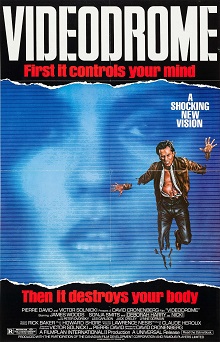Review – Videodrome (1983)

Grace from Film Overload takes a look at our Saturday evening feature screening of VIDEODROME. Watch this genre defining horror/sci-fi classic at this years festival on 31 October 2020 at 19.00pm. (some spoilers ahead!)
‘Cronenberg’s artistic vision of visceral sensuality, body horror and alluring conspiracies – brings a genre defining classic’
David Cronenberg’s legacy as a genre defining director began when his incredibly influential film Videodrome was released in 1983. Cinema of the 1980s still remains iconic to this day, with Videodrome solidifying its status due to Cronenberg’s artistic vision of visceral sensuality, body horror and alluring conspiracies.

We follow the sordid channel operator Max Renn (James Woods) who specialises in the adult entertainment industry. With audience expectations becoming harder to meet, he searches for something never seen before. Fortunately he stumbles across a seedy show broadcasting extreme torture and violence. However, his new-found show ‘Videodrome’ brings about horrid consequences.
The film also features Debbie Harry, or as some may know her, Blondie. Harry plays the masochistic Nikki Brand who sensationally thrusts Renn’s life into a chaotic oblivion. As with most of Cronenberg’s work Videodrome is not shy to venture into eccentric and surreal topics. The film works as a metaphorical standpoint, alongside the utilisation of horror iconography to create a transcendent experience.

From Cronenberg’s visual perspective we are manically treated to a spontaneous eruption of visceral images exhibiting fleshy horror. As aforementioned body horror is a keen contributor to the film, with blood, guts and gore heavily making an appearance. But it’s the treatment of the body within the film that fashions such a complex visual composition; the themes of violence that come from the channel Videodrome are not afraid to cross the line, with one particular scene exhibiting a human torso being ripped open, graphically exposing each vein and tendon.
Despite the brutal exposure of torture and violence, the film is yet to fall into the satirical gory horror of the eighties. Instead, the act of violence is a simulation to further the film’s powerful allegorical notion.

The film plays its message out via a morbid and torturous atmosphere that has no fear in pushing audiences limitations. At the time television was seen by many as the enemy, the ruthless manipulator causing havoc amongst the young. With the early eighties seemingly dooming the horror market by the video nasty scandal and an influx of graphic and violent horrors being imported across the world, it’s no surprise that the media spread fear. Although from today’s perspective the idea of TV haunting viewers is radically nonsensical, it was once a real ‘emergency’.
Cronenberg utilises and exploits this fear through directly mocking people’s responses to the media. Within Videodrome, this channel that Renn stumbles upon is powerful enough to cause hallucinations and psychically harm. The show is a weapon that can literally cause mass tumours, with the intention that anyone who would want to consume the snuff-like material coming from the channel deserves a fatal end.

Videodrome is a testing film, the characters are not necessarily likeable and the entire play-through is gloomy. Yet, it’s an unforgettable experience that uses its speculative nature and bitter eccentricity to coerce and distort the viewers expectations, making it a must see for all horror fans.

